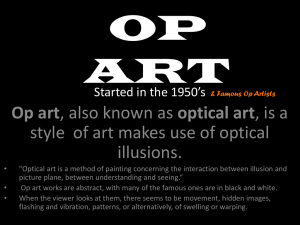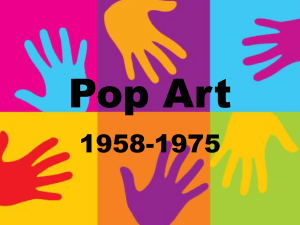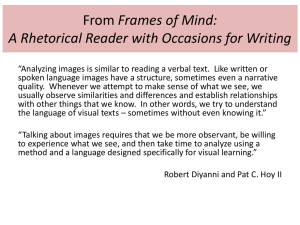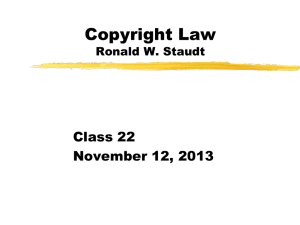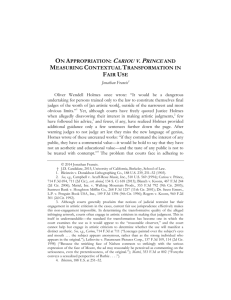Presentation - LOEX Annual Conference
advertisement
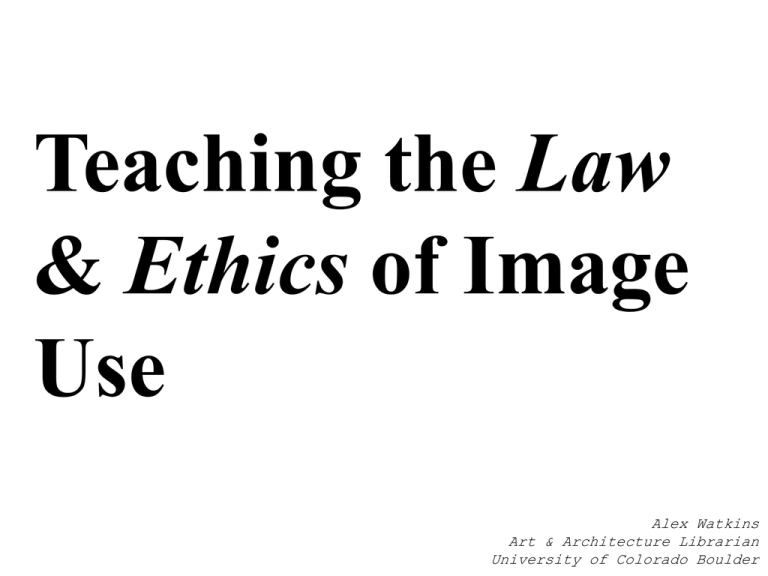
Teaching the Law & Ethics of Image Use Alex Watkins Art & Architecture Librarian University of Colorado Boulder Art has always built on the Past Apollo Belevedere Michelangelo, David Titian, Venus of Urbino Manet, Olympia Picasso, Women with a Straw Hat Jasper Johns, After Picasso Lichtenstein, Whaam and the comic source Andrea Blanch, Silk Sandals by Gucci Jeff Koons, Niagara Falls Images essential in a digital age • • • • • • • • • Blogs Presentations Papers Digital Scholarship Websites Flyers Social Media Art Videos Recycling imagery feels comfortable and commonplace. If one lives in a forest, wood will likely become one’s medium for creative play. If one grows up in a world filled with cheap, disposable images, they easily become the stuff of one’s own creative expression Olivia Gude Session Plan • • • • • Copyright & Fair Use Teaching the law of image use Ethics in image use Teaching ethics Case studies discussion What is the purpose of copyright? To promote creation of culture By rewarding creators with limited monopoly Applies only to Fixed Expression not the Idea Ed Ruscha, Some Real Estate Opportunities Eric Doeringer Copyright for Images Two Potential Layers of Copyright: The underlying object & the photograph Public Domain + Sufficiently Creative Work does not have copyright Photo does not have copyright Photo has copyright Work has copyright What is Fair Use? It is legal, unauthorized use of copyrighted material Allowed because the culture created is more valuable than the monopoly It creates a space for creativity, and is a safety valve for free speech The Four factors: Purpose and character of your use Picasso Guitar, Newspaper, Glass, Bottle The Four Factors: The nature of the copyrighted work Four Factors: The amount and substantiality of the portion taken Four Factors: The effect of the use upon the potential market Fair Use Narratives Shepard Fairey Mannie Garcia Teaching Copyright & Fair Use • No copyright scares, the point is not to make students afraid. • Case Studies + Discussion/Debate • Have Students come up with their own fair use narratives for their work. • Also an opportunity to discuss Creative Commons and how to find images effectively. Ethics in Image Use Art Rogers, Puppies Jeff Koons, String of Puppies Tom Forsythe, Food Chain Barbie Art Rogers, Puppies Jeff Koons, String of Puppies Gillian Wearing, Signs that say what you want them to say and not signs that say what someone else wants you to say Vaseline Ad, Sea of Skin Spencer Turk photograph Art Rogers, Puppies Jeff Koons, String of Puppies Patricia Caulfield Andy Warhol Shepard Fairey Mannie Garcia Patrick Cariou Richard Prince Morton Beebe, Cliff Diver at Acapulco Robert Rauschenberg, Pull they think it's just a photograph Arnold Newman The reason there’s a legal issue here is because there’s a moral one Patricia Caulfield Stephen Oakes, National Geographic Lisa Congdon Cory Archangel, Super Mario Clouds Christian Marclay, The Clock BuzzFeed Daily Mail Patrick Cariou, Yes Rasta Richard Prince, Canal Zone The ethnographic photograph is perhaps the paradigmatic appropriative object, born of an aggressive technology in contexts of political and cultural domination. Such photographs present a fixed point, literally, figurally, and metaphorically, of dispossession and appropriation. They render the bodies of the powerless through the intellectual and ideological categories of the powerful in relation to a series of dynamic axes-race, gender, subjugation, and their social classifications. Elizabeth Edwards Patrick Cariou, Yes Rasta Richard Prince, Canal Zone Patricia Caulfield Andy Warhol “Warhol had found the original photo in a women’s magazine; it had won second prize in a contest for the best snapshot taken by a housewife” Rainer Crone “Warhol was very innocent of doing a disservice to this photographer because this is not what you might call a ‘remarkable photograph.’ It was not an earthshaking photograph, but Warhol make a remarkable series of paintings out of it” Ivan Karp Teaching Ethics in Image Use • To separate the legal from the ethical • Even if you can, should you? • We want students to think critically about their own image use, and how they would feel if the tables were turned. • All images have subjects, meaning, artistic choices Richard Prince Case Richard Prince, Canal Zone Patrick Cariou, Yes Rasta Richard Prince, Canal Zone Patricia Caulfield Andy Warhol Shepard Fairey Mannie Garcia Morton Beebe, Cliff Diver at Acapulco Robert Rauschenberg, Pull Art Rogers, Puppies Jeff Koons, String of Puppies Christian Marclay, The Clock Thank You Further Reading Baselitz, Georg, Kirk Ambrose, Elizabeth Edwards, Ursula Anna Frohne, Cordula Grewe, Daniel Heller-Roazen, Ian Mclean, Saloni Mathur, Lisa Pon, and Iain Boyd Whyte. “Notes from the Field: Appropriation.” Art Bulletin 94, no. 2 (June 2012): 166–86. Buskirk, Martha. “Commodification as Censor: Copyrights and Fair Use.” October 60 (April 1, 1992): 83–109. doi:10.2307/779036. Buskirk, Martha. The Contingent Object of Contemporary Art. Cambridge, Mass: MIT Press, 2003. Gude, O. (2004). Postmodern Principles: In Search of a 21st Century Art Education. Art Education, 57(1), 6–14. King, Elaine A., and Gail Levin, eds. Ethics and the Visual Arts. New York: Allworth Press, 2006. McClean, Daniel, ed. The Trials of Art. London: Ridinghouse, 2007. McClean, Daniel, and Karsten Schubert, eds. Dear Images: Art, Copyright and Culture. London: Ridinghouse, 2002. Merryman, John Henry. Law, Ethics, and the Visual Arts. 4th ed. London ; New York: Kluwer Law International, 2002. Nelson, Robert S. “Appropriation.” In Critical Terms for Art History, edited by Robert S. Nelson and Richard Shiff, 160–73. 2nd ed. Chicago: University of Chicago Press, 2003.







